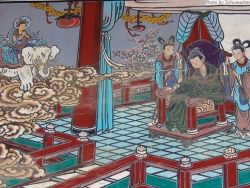Seppuku
To a warrior, life without honor is worse than death. A warrior who acts with dishonor on the battlefield will be ostracized by fellow warriors and many times bring disgrace upon his family for generations. A warrior will fight to the death because it is an honorable thing to do.
Jeremy Borda joined the Navy as an underage seaman and, through hard work, dedication, and perseverance, became an admiral and the Chief of Naval Operations (the highest position in the Navy) in the early 1990s. Throughout his career, he earned a multitude of military decorations and medals. In 1995, after hearing that a reporter was to interview him in the afternoon about one ribbon he was wearing that his critics said he was not authorized to wear, Admiral Borda went home for lunch, went to his back yard, sat on a bench, and killed himself with a firearm. Later investigation showed that the error in wearing the medal was not his fault. Even though his death served no useful purpose, it did show the spirit of a true warrior who chose death over dishonor.
Hara-kiri
Seppuku,"stomach cutting" or "belly slicing," also known in English as hara-kiri (a term regarded as vulgar by the Japanese), is a form of Japanese ritual suicide by disembowelment. Seppuku was a key part of bushido, the code of samurai warriors. It as an act of bravery used to avoid surrender, capture, or shame. Seppuku could used to demonstrate loyalty toward one's deceased lord or husband, to show one's disagreement with their daimyo (feudal lords), performed upon the order of their daimyo, or it could be permitted as an alternative to execution. Sometimes a daimyo was called upon to perform seppuku as a part of a peace agreement to weaken the defeated clan sand cease resistance.
Seppuku meant a samurai could die with his reputation intact or even enhanced; it could free the samurai's family from any culpability from his acts. Since the main point of the act was to restore or protect one's honor as a warrior, those who did not belong to the samurai caste were never ordered or expected to commit seppuku.
Samurai women could only commit seppuku with permission. The methods of seppuku for men and women are different. Men cut open their midsections, but the women would cut their throats, in version of seppuku called jigai. The difference was probably not to make it easier for women to die, but because of a reverence for the womb where all human life begins. The woman's legs were tied together to ensure a "decent" posture in death.
The first known Samurai to commit seppuku in a ritualized manner was Minamoto Tametomo, a samurai turned outlaw after being banished from service. He eluded capture for quite some time, but in 1170 an overwhelming force was sent to capture him. When he saw he could not win or escape, Tametomo knelt to the ground and cut out his own intestines rather than surrender, perhaps as a sign of contempt for his opponents.
The cutting of the abdomen released the samurai’s spirit in a most dramatic fashion, but it was an extremely painful and unpleasant way to die so sometimes a loyal comrade was asked to cut off his head at the moment of agony. By 1180, the practice had become more formal when Minamoto Yorimasa, who was wounded in the leg, could no longer fight, and considered death more honorable than surrender, ordered his assistant Watanabe Chojitsu Tonau to cut off his head. Tonau refused to carry out the command while his master still lived, so Yorimasa said a prayer for his two sons who had died in the battle and wrote a poem as his last act:
- Like a fossil tree which has borne not one blossom Sad has been my life Sadder still to end my days Leaving no fruit behind me.
Yorimasa then pulled his short sword and cut open his midsection, fell on the blade, and waited to die. After his death, his assistant cut off his master’s head and hid it in the water to keep the enemy from defiling it.
As time passed, the idea of using an assistant became more prevalent and the assistant became known as the kaishakunin. Sometimes the kaishaknin’s duty would be to act in a moment of surprise and cut off the master’s head before he could inflict pain upon himself, thus absolving the master of any blame. However, the most honored warriors were the ones who refused a kaishakunin and performed seppuku with no assistance. Some of these would cut open their abdomen, clean the sword, and dip a brush into their own body to compose their jisei no ku (final poem) in their own blood as they waited patiently for death.
Procedure
Seppuku was usually performed using a wakizashi (short sword) or a tantō (knife). It could take place with preparation and ritual in the privacy of one's home, or quickly with no preparation on a battlefield.
In a seppuku ritual, the samuari was bathed, dressed in white robes, and fed his favorite meal. When he finished the meal, a tanto or wakazashi was placed on his plate. The warrior would prepare for death by writing a death poem. It was usually determined in advance when the kaishakunin would make his daki-kubi, the decapitation stroke. With his kaishakunin standing by, he would open his kimono (robe), take up his blade and plunge it into his abdomen, first making a left-to-right stroke and then a second slightly upward stroke to spill out the intestines.
On the upward stroke, the kaishakunin would perform daki-kubi. There were instances when the head flew off, so it was best for the daki-kubi to leave a little band of skin remaining so the head did not fly off toward the verifying officials. Because of the precision necessary for such a cut, the kaishakunin was often a skilled swordsman. If a defeated warrior had fought honorably and well, an opponent who wanted to salute his bravery would volunteer to act as his kaishakunin.
Some samurai chose to perform a form of seppuku known as jūmonji-giri "cross-shaped cut" in which there is no kaishakunin to provide a quick end to the samurai's suffering. It involves a second and more painful vertical cut across the belly and the samurai was expected to bear his suffering quietly while bleeding to death.
Seppuku has also been used as capital punishment for disgraced samurais, especially for those who had committed serious offenses such as murder, robbery, corruption, or treason. The samurai was given a set time to commit seppuku, usually before sunset on a given day. If the samurai was uncooperative, he would be restrained and forcibly decapitated. Unlike voluntary seppuku, seppuku carried out as capital punishment did not necessarily absolve the victim's family of the crime.


